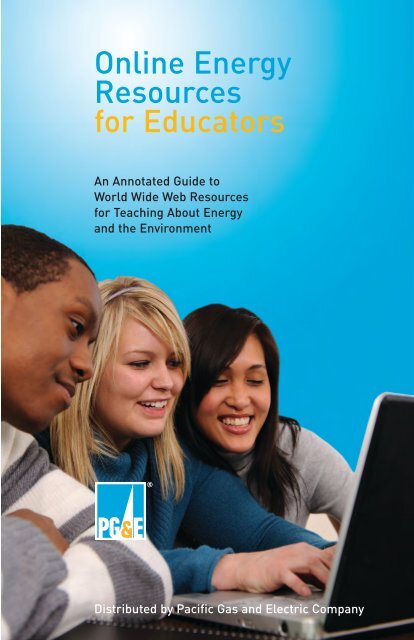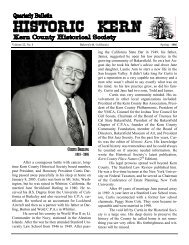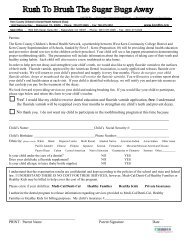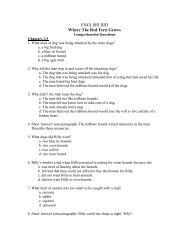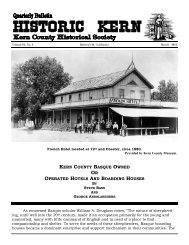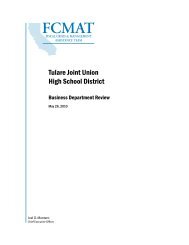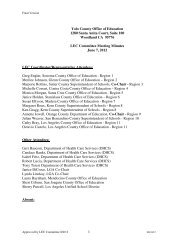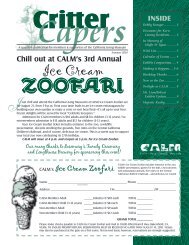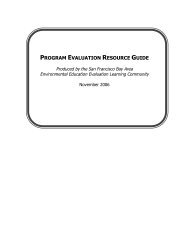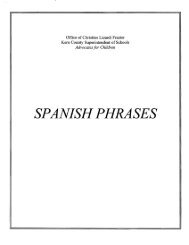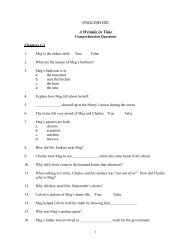Online Energy Resources for Educators
Online Energy Resources for Educators
Online Energy Resources for Educators
You also want an ePaper? Increase the reach of your titles
YUMPU automatically turns print PDFs into web optimized ePapers that Google loves.
<strong>Online</strong> <strong>Energy</strong><strong>Resources</strong><strong>for</strong> <strong>Educators</strong>An Annotated Guide toWorld Wide Web <strong>Resources</strong><strong>for</strong> Teaching About <strong>Energy</strong>and the EnvironmentDistributed by Pacific Gas and Electric Company
WelcomePacific Gas and Electric Company (PG&E) has assembledthis guide to help you locate materials on the World WideWeb that can help your students learn about energy andthe environment.PG&E has created curricula based programs specifically <strong>for</strong>schools which correlate to the Cali<strong>for</strong>nia Department ofEducation Content Standards. These programs are featuredin the first section of this booklet. The second section containsmany relevant Web sites published by governmental, publicand private organizations.Use this guide to find lesson plans you can print out ordownload to your computer, order free and low-costresources like handouts and posters, learn about upcomingworkshops, and link to additional tools and in<strong>for</strong>mation.Sites marked with this Web surfer icon includespecial content <strong>for</strong> students to use on their own.Remember:Web sites are continually updated and redesigned. Someaddresses listed here may have changed. If you find that anaddress no longer works, try this: Go to the site’s home page.You may find a link there to the resource you are looking <strong>for</strong>,or the page may include a search box. You can also search<strong>for</strong> the material you want by entering its name into a searchengine such as Google (www.google.com) or Yahoo(www.yahoo.com).We welcome your recommendations <strong>for</strong> additional Web sitesto include in a future version of this guide. Please send yoursuggestions to: energenius@pge.com.Pacific Gas and Electric Company (PG&E) does not endorse the specific Web sites ormaterials or programs provided by the various agencies and organizations listed inthis guide. Teachers should evaluate and select materials and programs that bestmeet their educational goals and the needs of their students.
PG&E’s Educational ProgramsEducational Programs <strong>for</strong>PG&E’s School CustomersPG&E’s Energenius ® , Safe Kids, and Solar Schools programs and the<strong>Energy</strong> Coalition’s PEAK program help educators teach Cali<strong>for</strong>nia’sK-12 students to use energy wisely and safely. The free instructionalmaterials equip teachers with accurate in<strong>for</strong>mation and effective toolsthat address state content standards in math and science. All of thematerials are available in English and some in Spanish.ENERGENIUSThe Energenius Educational Series provides engaging, interactiveprograms to teach elementary and middle school students about energyconservation. These curricula help students understand how they canmake a positive difference <strong>for</strong> the environment. Make learning fun with:• Clear, detailed lesson plans and activities• Colorful posters, handouts and calendars• Lively videos and learning games <strong>for</strong> groups• Entertaining animated characters who illustrate examples of wasteand motivate students to be mindful about their own energy useThe program is divided into these grade levels:• Kindergarten Program• Energenius Habits and Primary Safety (grades, 1-3)• E Program (grades, 4-5)• Intermediate Safety (grades, 4-6)• Bill Buster Program (grades, 6-8)• Light Right Program (grades, 6 and up)Order materials at www.pge.com/energenius.SAFEKIDSThe Safe Kids Program helps students learn how to stay safe aroundnatural gas and electricity. The program includes:• Individual and group learning activities, facilitated discussion,experiments, quizzes and interactive online games• Comprehensive teachers’ guides• Lesson plans (including pre- and post-tests) that help teacherscreate an energy education plan tailored to students’ needsSafe Kids is divided into two parts—an elementary section suitable<strong>for</strong> classroom or home use with students in grades K-5 and a sciencesection <strong>for</strong> grades 6-10, including:• Aunt Sarah and the Amazing Power, Electricity and Natural Gas(grades, K-2)
PG&E’s Educational Programs• Stay Safe Around Electricity and Natural Gas (grades, 3-4)• Experiments to Explore Electricity (grades, 3-6)• Electrical & Natural Gas Safety World (grades, 4-6)• The Shocking Truth about Electricity and Natural Gas (grades, 5-6)• Science and Safety of Electricity and Natural Gas (grades, 6-8)Order materials at www.pge.com/safekids.SOLAR SCHOOLS PROGRAMThe Solar Schools Program enables public school students inunderserved PG&E communities to learn about solar energythrough hands-on projects.• Solar Installation: Adding a solar panel demonstrates a school’scommitment to energy conservation and may save several hundreddollars in energy costs each year. The installation package includesan online monitoring tool that provides real-time data on thesystem's activity and allows students to compare their solar panel'soutput with that of other solar schools across the state.• Bright Ideas grants: Grant awards ranging from $1,000 to $10,000are available to fund local green or sustainable solar energy-relatedschool projects such as solar ovens and school gardens.• Teacher Training: All K-12 public school teachers in PG&E'sservice area are invited to attend our free one-day workshopstaught by instructors from the National <strong>Energy</strong> EducationDevelopment Project. The workshops help teachers learn to usethe curriculum to make math, science and English fun <strong>for</strong> studentsby implementing innovative energy units in their classrooms.To learn more, visit www.pge.com/solarschools.PEAKThe <strong>Energy</strong> Coalition offers PEAK, a standards-based educationprogram. PEAK teaches the science of energy while empoweringCali<strong>for</strong>nia students in grades 3-7 to become Smart <strong>Energy</strong> Managersin their homes, schools and communities.PEAK provides at no cost:• A Web site containing fun, interactive games and quizzes <strong>for</strong> students• Tips <strong>for</strong> saving energy at home and at school• Professional development <strong>for</strong> educators• An easy to follow, standards-based guidebook with supplies <strong>for</strong>hands-on activities• Assemblies, contests and fundraisers <strong>for</strong> your schoolTo find out if there is a PEAK program near you, or to learn how toparticipate, visit www.peakstudents.org.
<strong>Online</strong> <strong>Energy</strong> <strong>Resources</strong>Page 1AIRNowwww.airnow.govThe AIRNow site provides quick access to national air qualityin<strong>for</strong>mation. A full-color map gives an overview of air quality inthe USA and is updated daily.www.airnow.gov/index.cfm?action=static.resourceThe Teachers' page provides links to air quality and environmentalcurriculum resources, as well as state and local air quality Web sitesdesigned specifically <strong>for</strong> teachers and students.www.airnow.gov/index.cfm?action=aqikids_new.mainAn air quality map and Webcams are available <strong>for</strong> childrenages 7-10. Buster Butterfly helps explain air quality days tokindergarten and 1st grade students.Alliance to Save <strong>Energy</strong>www.ase.org/section/_audience/educatorsThe Alliance's Educator's page features links to detailedmultidisciplinary lesson plans that bring energy efficiency intothe classroom <strong>for</strong> K-12 students.www.ase.org/section/program/greenschlThis site provides newsletters on recent developments in energyefficiency, Green School case studies and resources <strong>for</strong> studentsand teachers.Bonneville Power Administration (BPA)www.bpa.gov/<strong>Energy</strong>/N/educationBPA provides links to energy resources <strong>for</strong> elementary and secondarystudents. Teacher resources, including a fuel cell curriculum, are alsoincluded.www.bpa.gov/Corporate/KR/ed/energyaudit/homepage.shtmlThe <strong>Energy</strong> Audit Workbook and Training Manual is an eight-chaptercourse of study that a student team can use to conduct an energy auditof their high school.www.bpa.gov/<strong>Energy</strong>/N/education/ClassroomThis site provides energy conservation lesson plans and classroommaterials <strong>for</strong> grades 4-5. An energy conservation poster puzzle,coloring pages, and a chart depicting energy use and waste in a child'sbedroom are also included.
<strong>Online</strong> <strong>Energy</strong> <strong>Resources</strong>Page 2www.bpa.gov/corporate/KR/ed/6-curricula.htmThe <strong>Resources</strong> <strong>for</strong> Teachers’ page describes and links to energyconservation lesson plans <strong>for</strong> grades K-8. BPA's <strong>Energy</strong> Smarts TeamTraining Manual is a teacher's guide to energy conservation activities <strong>for</strong>elementary and middle school students.Cali<strong>for</strong>nia Air <strong>Resources</strong> Boardwww.arb.ca.gov/knowzone/knowzone.htmThe Air <strong>Resources</strong> Board introduces students to issues of airquality and air pollution in Cali<strong>for</strong>nia. The Know Zone's Kids'Stuff site has a coloring book that can be printed out(in English and Spanish) and interactive games.Cali<strong>for</strong>nia Climate Change & <strong>Energy</strong> Education<strong>Resources</strong> Catalogwww.energy-education.net/k12.htmThis site provides a K-12 catalog of resources <strong>for</strong> teaching studentsabout climate change, conservation, energy alternatives, and basicprinciples on energy, electricity, and electrical power. It links to lessonplans, curriculum units, teacher training workshops, hands-on projectsand field trips.Cali<strong>for</strong>nia Department of Education —Office of Environmental Educationwww.cde.ca.gov/pd/ca/sc/oeeintrod.aspThis site provides a source of in<strong>for</strong>mation on environmental educationalcurriculum resources <strong>for</strong> Cali<strong>for</strong>nia schools. Links include the Child'sPlace in the Environment curriculum guides <strong>for</strong> elementary schoolteachers, resource guides, and the Environmental Education GrantProgram (EEGP). Cali<strong>for</strong>nia <strong>Energy</strong> Commission (CEC)www.energy.ca.govThe CEC portal provides access to a number of energyresources on climate change, solar, green house gases,energy savings tips and much more.Cali<strong>for</strong>nia <strong>Energy</strong> Commission — <strong>Energy</strong> Questwww.energyquest.ca.gov<strong>Energy</strong> Quest is a comprehensive, energy education site wherestudents can research energy-related issues and play a seriesof interactive games that teach energy and conservation.
<strong>Online</strong> <strong>Energy</strong> <strong>Resources</strong>Page 3www.energyquest.ca.gov/teachers_resources/ index.htmlThe site's teacher resources section includes background material,recommended books, and extensive links to K-12 energy educationlesson plans on other sites.Cali<strong>for</strong>nia Environmental Education Interagency Network(CEEIN)www.calepa.ca.gov/education/CEEIN/<strong>Resources</strong>CEEIN provides resources <strong>for</strong> teachers to help them integrateenvironmental issues into their lesson plans.Cali<strong>for</strong>nia Environmental Protection Agencywww.calepa.ca.gov/EducationA portal to the agency's K-12 educational programs, including thosefrom the Air <strong>Resources</strong> Board, Cali<strong>for</strong>nia Integrated Waste ManagementBoard, Office of Environmental Health Hazard Assessment and the StateWater <strong>Resources</strong> Control Board.Cali<strong>for</strong>nia Integrated Waste Management Board (CIWMB)www.ciwmb.ca.gov/SchoolsThe CIWMB site features environmental educational publications(elementary and secondary), including waste prevention curricula.Teachers will also find in<strong>for</strong>mation on developing school wasteprevention and recycling programs and funding sources <strong>for</strong>environmental, recycling, or science literacy projects.Cali<strong>for</strong>nia Regional Environmental Education Community(CREEC Network)www.creec.orgThe CREEC Network links to environmental educational resourcesand libraries in Cali<strong>for</strong>nia. CREEC's searchable Resource Directoryincludes over 1,000 environmental education providers and over2,000 programs/resources available to educators in Cali<strong>for</strong>nia.Charles Edison Fundwww.charlesedisonfund.orgThis site offers easy-to-per<strong>for</strong>m, science-teaching experiments <strong>for</strong>grades 4-12. These projects focus on conservation, alternative energysources, static electricity, energy <strong>for</strong> the future and environmentalexperiments. There is also in<strong>for</strong>mation on the Edison Awards Program<strong>for</strong> student participation in scientific projects.
<strong>Online</strong> <strong>Energy</strong> <strong>Resources</strong>Page 4ClassroomEarthwww.classroomearth.orgThe National Environmental Education Foundation's (NEEF)ClassroomEarth site lists and describes in detail what it hasdetermined to be the ten "most popular and widely used environmentaleducation programs <strong>for</strong> K-12 classrooms."Climate Change Education.orgwww.climatechangeeducation.orgClimate Change Education.org is a portal that provides links to a widevariety of educational and scientific resources on climate change,including K-12 lesson plans and ideas <strong>for</strong> student projects.www.globalwarmingkids.netClimate Change Education.org's portal to global warming <strong>for</strong>students links to interactive games and other web resourcesand lists DVDs, videos, books, magazines, and science centersrelevant to climate change.Earth 911 (Making Every Day Earth Day)www.earth911.orgThis site links to state and local government programs addressingissues such as recycling, waste management, and environmentalpolicy.www.earth911.org/<strong>for</strong>-studentsThe student section (grades, K-12) contains games, activities,and in<strong>for</strong>mation on recycling and reuse, including electronicwaste.EarthDay.govwww.earthday.govThe federal government's portal to Earth Day events and in<strong>for</strong>mationprovides connections to various state government sites. Teachers canfind ideas <strong>for</strong> classroom lessons and activities, as well as a history ofEarth Day and related legislation from 1970 to the present.Earth Teamwww.earthteam.netThis site disseminates in<strong>for</strong>mation on environmental education and"action projects" suitable <strong>for</strong> classrooms. Project descriptions includeobjectives and extensive links to other resources. Earth Team's GreenNews is an online newsletter by and <strong>for</strong> teens www.thegreennews.net.
<strong>Online</strong> <strong>Energy</strong> <strong>Resources</strong>Page 5Electrical Safety Worldwww.sce.com/kidsSouthern Cali<strong>for</strong>nia Edison's Electrical Safety World features severallively interactive pages on electrical safety <strong>for</strong> kids. The site includesa safety certificate that can be printed out <strong>for</strong> classroom use and ateachers' guide.ENC Learning Inc.www.goenc.comThe goENC site offers resource in<strong>for</strong>mation <strong>for</strong> teaching K-12 scienceand math classes, including energy-related topics. The site featuresa searchable database and a descriptive catalog of resources fromhundreds of organizations and publishers. Links to workshopmaterials, education periodicals, online teacher courses, andteacher talk sites.<strong>Energy</strong> Hogwww.energyhog.orgThe <strong>Energy</strong> Hog Challenge educates students in grades 3-6 onhow to be responsible energy users. "The Challenge” helpsdevelop student skills in science, math, technology, languagearts, critical thinking and social studies. A student guide and ateacher guide are available.<strong>Energy</strong>Netwww.energynet.netThe <strong>Energy</strong>Net learning program <strong>for</strong> K-12 students integratestechnology, standards-based learning, and work-place skills. Titlesinclude: <strong>Energy</strong> Detectives (elementary level) and Home <strong>Energy</strong>Makeover, <strong>Energy</strong> Auditing, <strong>Energy</strong> Engineers Community, and<strong>Energy</strong> Consultants (middle and high school level). Users must buythe program.<strong>Energy</strong>Smart Schoolswww.eere.energy.gov/buildings/energysmartschools<strong>Energy</strong>Smart Schools is a Department of <strong>Energy</strong> program that seeksmajor improvements in the energy efficiency of American schoolbuildings.www.eere.energy.gov/education/lessonplansThis program offers links to more than 350 lesson plans and activitieson energy efficiency and renewable energy <strong>for</strong> grades K-12. Eachlisting includes a detailed summary identifying curriculum integration,time, materials, and national standards. The lesson plans aredownloadable from the <strong>Energy</strong>Smart site.
<strong>Online</strong> <strong>Energy</strong> <strong>Resources</strong>Page 6ENERGY STAR Kidswwwenergystar.gov/index.cfm?c=kids.kids_indexStudents learn how to protect the environment on thisinteractive site, by making changes in their homes. They canwatch a slide show on global warming and learn about"superhero energy stars" and energy sources, uses,and consequences.Exploratorium Museumwww.exploratorium.eduThe San Francisco Exploratorium museum site providesa variety of interactive, online educational exhibits onscience-related subjects. The Exploratorium produces its ownWebcasts and has its own Webcam. Its digital library issearchable online.www.exploratorium.edu/climateThe Exploratorium's Global Climate Change Research Explorer pagesdisplay climate models and scientific data relating to the atmosphere,oceans, and polar caps.Flex Your Powerwww.fypower.orgThis site provides a variety of energy efficiency and conservationin<strong>for</strong>mation covering incentives/rebates, technical assistance,retailers, product guides, and case studies.www.fypower.org/inst/edu.htmlThe site's education solutions section details how schools may reducetheir energy bills by using energy more efficiently and by installingenergy-efficient equipment.www.fypower.org/inst/tools/resources.htmlFlex Your Power also provides an online search engine <strong>for</strong> locatingin<strong>for</strong>mation related to energy and water efficiency.Florida Solar <strong>Energy</strong> Centerwww.fsec.ucf.edu/en/education/k-12/curriculaThe K-12 program gives teachers online access to curriculum unitsfocusing on alternative energy technologies and the understanding ofnatural systems. Topics include Solar <strong>Energy</strong>, Alternative Fuel, High<strong>Energy</strong> Hydrogen and Building Per<strong>for</strong>mance.
<strong>Online</strong> <strong>Energy</strong> <strong>Resources</strong>Group tours of the FolsomPowerhouse are availablethroughout the week byspecial arrangement.Call 1-916-985-4843<strong>for</strong> more in<strong>for</strong>mation.Page 7Folsom Powerhouse SHP, Electricity Unitwww.parks.ca.gov/pages/501/files/unit.pdfFolsom Powerhouse State Historic Park offers adownloadable curriculum guide on electricity in PDF<strong>for</strong>mat. The curriculum guide contains 14 individuallesson plans using the powerhouse and it's history as afocus. It includes quizzes, scientific investigations andhandouts. (www.parks.ca.gov/pages/501/files/guide.pdf)Foundation <strong>for</strong> Environmental Education (FEE)www.the-environment.orgThe <strong>Energy</strong> Education section of this site provides an overviewof <strong>for</strong>ms of energy and features learning modules on zeroemission technologies, an interactive primer on how a powerplant works, and an FAQ section on the greenhouse effect.Foundation <strong>for</strong> Water and <strong>Energy</strong> Education (FWEE)www.fwee.org/education.htmlFWEE offers a six-unit, hands-on curriculum entitled The Nature ofWater Power <strong>for</strong> grades 4-8. The focus is on the Northwest states,where a large percentage of the electricity is generated by hydro power.Franklin Institute Science Museum — Community ScienceAction Guideswww.fi.edu/guide/energy.htmlThe Franklin Institute has produced a series of detailed energy resourceguides <strong>for</strong> both upper primary and upper secondary students, addressingenergy efficiency, the oil supply, and global warming.How Stuff Workswww.howstuffworks.comA searchable database that can be used by students and teachers tofind answers to questions about the workings of science and technology.The company promises to provide a "source of credible, unbiased, andeasy-to-understand explanations of how the world actually works."IEEE Virtual Museumwww.ieee-virtual-museum.orgThis Institute of Electrical and Electronic Engineers' VirtualMuseum is designed <strong>for</strong> students ages 10-18, teachers and thegeneral public. The aim of the museum is to create a betterunderstanding of the principles of electrical and in<strong>for</strong>mationsciences within a historical context.
<strong>Online</strong> <strong>Energy</strong> <strong>Resources</strong>Page 8The Learning Teamwww.learningteam.orgThis site offers <strong>for</strong> sale two CD-ROM programs on energy conservation<strong>for</strong> grades 8-12: The Sun's Joules (about renewable energy and theenvironment) and The Green Home ("A new 'green' way of building andoperating your home"). Both programs include real-world, interactiveexercises.Marian Koshland Science Museumwww.koshland-science-museum.org/teachers/ index.jspThe Teachers & Learning section of the Marian Koshland ScienceMuseum site offers inquiry-based student activities that adhere toNational Science Education Standards.www.koshland-science-museum.org/exhibitgcc/index.jspGlobal Warming Facts and Our Future isa "virtual field trip" exploring the causesand impact of climate change. Includespre-visit and follow-up teaching activities.Take a virtual field trip to learn about thecauses and impacts of climate change.Take a virtual field trip tolearn about the causes andimpacts of climate change.National <strong>Energy</strong> Education Development (NEED) Projectwww.need.orgThe NEED Project provides a variety of online student and teacherenergy education guides <strong>for</strong> grades K-12. Curriculum topics includewind and solar energy, and solar schools. Hands-on energy kits canbe ordered from the project. The site provides in<strong>for</strong>mation onteacher/student training opportunities, as well as curriculum guides,and student activities.National <strong>Energy</strong> Foundation (NEF)www.nef1.orgThe NEF site provides curriculum, training, and materialsdevoted to energy and natural resources issues. The <strong>Educators</strong>page has activities <strong>for</strong> students related to fossil fuels and theconservation of energy.
<strong>Online</strong> <strong>Energy</strong> <strong>Resources</strong>Page 9North American Association <strong>for</strong> Environmental Education(NAAEE)www.naaee.orgThe NAAEE is a network of professionals, students, and volunteersworking in the field of environmental education. It offers publications<strong>for</strong> purchase that focus on guidelines <strong>for</strong> development of environmentaleducation programs. Its EE-Link is a searchable database ofenvironmental education resources on the Internet (requiresmembership).Northeast Sustainable <strong>Energy</strong> Association (NESEA)www.nesea.org/education/edmaterialsThe NESEA offers lesson plans and interdisciplinary units (some in PDF<strong>for</strong>mat) <strong>for</strong> students in grades 3-12 on topics such as renewable energy,alternative fuels and personal energy choices.The Northern Cali<strong>for</strong>nia Solar <strong>Energy</strong> Association (NCSEA)www.norcalsolar.org/<strong>Resources</strong>NCSEA's <strong>Resources</strong> section contains pictures and in<strong>for</strong>mation on solartechnology, photovoltaic basics, and best practices <strong>for</strong> "solar friendly"cities.PG&E Energenius Programwww.pge.com/energeniusThe PG&E Energenius Educational program focuses on energyefficiency and gas and electric safety education <strong>for</strong> grades K-8.Curriculum materials are provided at no cost to schools withinthe PG&E service area. The Energenius Educational Series comescomplete with teacher curriculum guides and sets of student activities.PG&E Home <strong>Energy</strong> Analyzerwww.pge.com/energysurveyAn audit of home energy use is available on this interactive, Web-basedsurvey that produces a report with tailored recommendations <strong>for</strong> savingenergy and reducing utility bills. From answers to simple multiple-choicequestions about home and household appliances, the Home <strong>Energy</strong>Analyzer generates a list of ways to save energy and compares energyuse to that of other similar homes.
<strong>Online</strong> <strong>Energy</strong> <strong>Resources</strong>Page 10PG&E Safe Kidswww.pge.com/safekidsTeachers in the PG&E service area can order free booklets on safetyaround electricity and natural gas. Safe Kids materials are designed <strong>for</strong>students in grades K-8. Some of the materials are also availablein Spanish.PG&E Solar Schools Programwww.pge.com/solarschoolsThis site provides K-12 educators in<strong>for</strong>mation,eligibility requirementsand application <strong>for</strong>ms <strong>for</strong> three solar school programs offered by PG&E.One program includes a solar installation at schools of a one kilowattphotovoltaic system that converts sunlight into electricity. Anothersolar program, Bright Ideas Grants, is available to schools to supportinnovative classroom and extracurricular solar science programs. Thethird program, a one-day, solar energy training course, is offered toeducators throughout northern and central Cali<strong>for</strong>nia. Participantsreceive curriculum materials to support hands-on energy units in theirclassrooms.PEAK students.netwww.peakstudents.orgPEAK is an educational program designed to teach students and theirfamilies about energy conservation practices. Students learn theimportance of shifting energy usage off of peak-demand times andabout renewable energy sources and cutting-edge energy-efficienttechnologies.www.peakstudents.org/game<strong>Energy</strong> Challenge is an interactive simulation game <strong>for</strong> kids,hosted by the action hero Bulbman and his nemesis <strong>Energy</strong>Sucker.www.peakstudents.org/teachers_cornerThe Teacher's Corner (password required) provides access to ateacher's guide and teacher and student pages in English and Spanish.Planet Pollutowww.planetpolluto.com/about.htmlSave Planet Polluto is an interactive simulation game <strong>for</strong> kidsabout the effects of air pollution. It is available on CD-ROM freeof charge throughout the Sacramento region or may be orderedin bulk at low cost.
<strong>Online</strong> <strong>Energy</strong> <strong>Resources</strong>Page 11Project Learning Treewww.plt.orgAn award-winning, interdisciplinary environmental education program<strong>for</strong> grades K-12 is administered by the American Forest Foundation.This site offers <strong>for</strong> purchase a multimedia <strong>Energy</strong> & Society learning kitthat integrates music and dance to enhance the study of energy issues.The kit includes an activity guide, a music CD, a dance DVD, posters,and background material <strong>for</strong> teachers.The Rahus Institutewww.rahus.orgThe Rahus Institute's Solar School program <strong>for</strong> grades K-12 offers afive-day summer institute and various six-hour workshops whereeducators learn about solar power and build solar powered projectsto prepare <strong>for</strong> teaching about solar energy. The Rahus’ site also includesnews updates on solar energy events and legislation in Cali<strong>for</strong>nia. Anassortment of solar educational kits and guidebooks <strong>for</strong> projects maybe purchased on the site.Rocky Mountain Institute (RMI)www.rmi.orgThis nonprofit organization works to foster efficient and restorative useof resources to create a more sustainable world. Web page fact sheetsoffer students and teachers in<strong>for</strong>mation about energy and how it isused. Includes a library of Rocky Mountain Institute publicationsavailable online.www.rmi.org/sitepages/pid300.phpThe RMI <strong>for</strong> Kids' page offers links to in<strong>for</strong>mation about energyand water <strong>for</strong> students in grades 4-6.Science Buddieswww.sciencebuddies.orgThis nonprofit organization has developed science project ideaswith step-by-step guidelines and an online mentoring program<strong>for</strong> K-12 students. A team of volunteer scientists monitors the"Ask an Expert" <strong>for</strong>um, and teacher resources are provided <strong>for</strong>planning science fairs.
<strong>Online</strong> <strong>Energy</strong> <strong>Resources</strong>Page 12Climate change andair pollution from aCali<strong>for</strong>nia perspectiveScience NetLinkswww.sciencenetlinks.comThis site provides K-12 teachers with Internet-based learning activitiesand lesson plans <strong>for</strong> the classroom. All site content is organized bygrade around benchmarks <strong>for</strong> science literacy. <strong>Energy</strong>-related lessonsinclude home energy conservation, energy sources and use, renewableenergy, urban ecosystems (ecology), and more.Solar <strong>Energy</strong> International (SEI)www.solarenergy.orgSEI promotes renewable energy resources of solar, wind, and waterthroughout the world. On the site are energy facts about renewables,articles on renewable energy, and links to related sites. Teachersseeking in<strong>for</strong>mation on college courses in solar education can go to:www.solarenergy.org/resources/education_table.pdf.www.solarenergy.org/resources/kids.htmlSEI's Kids Info page provides answers to questions about thesun and solar energy and links to online video tutorials.Union of Concerned Scientists (UCS)www.ucsusa.org/clean_energyThe UCS Clean <strong>Energy</strong> page features fact sheets on sustainable energysolutions and policies, including <strong>Energy</strong> 101, Coal vs. Windpower: YouJudge, and Just the Facts, a searchable database of scientific insightinto the risks of fossil fuels and the benefits of renewable energy.www.ucsusa.org/clean_cali<strong>for</strong>niaThe UCS Clean Cali<strong>for</strong>nia page accesses resources on airpollution, climate change, and "clean" motor vehicles.This site also links to fact sheets and reports covering thefollowing topics: global warming and Cali<strong>for</strong>nia, Cali<strong>for</strong>niavehicles and diesel engines, Cali<strong>for</strong>nia clean energy, andclearing the air in the San Joaquin Valley.www.ucsusa.org/assets/documents/global_warming/CA_Curriculum_guide_FINAL.pdfConfronting Climate Change in Cali<strong>for</strong>nia: Ecological Impacts on theGolden State, an eight-lesson curriculum guide <strong>for</strong> grades 9-12, is alsoavailable from the UCS.
<strong>Online</strong> <strong>Energy</strong> <strong>Resources</strong>Page 13The Urban Forest Ecosystems Institutewww.selectree.calpoly.eduPlanting trees can reduce energy costs by providing shade andprotection from the elements. The Urban Forest Ecosystems Institute'stree selection guide provides an easy way to select a tree based onclimate zone. In<strong>for</strong>mation is also provided on utility precautions, firesafety, root damage potential, invasive plants, hazardous trees, andtree maintenance.U.S. Department of <strong>Energy</strong> (DOE): Students and Kidswww.energy.gov/<strong>for</strong>studentsandkids.htmThe Students and Kids’ page contains material <strong>for</strong> conductingboth a home energy audit and a home energy checkup. The sitealso has a glossary, a fun facts section and links to kids’ pagesat a number of the DOE national laboratories.DOE: <strong>Energy</strong> In<strong>for</strong>mation Administration (EIA)www.eia.doe.gov/bookshelf/eer/kiddietoc.html<strong>Energy</strong> Education <strong>Resources</strong>: K-12 is a list of free or low-cost,energy-related educational materials published by the <strong>Energy</strong>In<strong>for</strong>mation Administration. It is updated annually and available inprint and online.www.eia.doe.gov/kidsThe EIA's extensive and colorful <strong>Energy</strong> Kid's page offers ahistory of energy; a fun and games page with quiz, puzzles, andvirtual field trips; and energy facts pages where the sources,uses, science, and saving of energy can be researched. Thepage also reports on energy news and provides help on sciencefair projects with NEED Project materials.DOE: National Renewable <strong>Energy</strong> Laboratorywww.nrel.gov/educationThis site offers in<strong>for</strong>mation to educators on research internships andfellowships, mentoring, tutoring, seminars, competitions, awards,special events, and after-school programs. In addition to instructionaldevelopment opportunities, teachers are provided with renewable energyand energy efficiency curricula <strong>for</strong> grades K-12.DOE: Office of <strong>Energy</strong> Efficiency and Renewable <strong>Energy</strong>www.eere.energy.govThis government Web site provides a gateway to many onlinedocuments on energy efficiency and renewable energy.
<strong>Online</strong> <strong>Energy</strong> <strong>Resources</strong>Page 14www.eere.energy.gov/education/lessonplansThis site provide more than 350 lesson plans and activities on energyefficiency and renewable energy <strong>for</strong> grades K-12. The lesson plans aresearchable by subject and grade level.www.eere.energy.gov/kidsThe kids’ site includes a variety of interactive games andactivities, including Roofus' Solar and Efficient Home, <strong>Energy</strong>Quest, games where kids fight the "energy monkeys," and the<strong>Energy</strong> Kid's Page with riddles, virtual field trips, energy slang,puzzles, scavenger hunt, activity book, and a quiz. The site alsoincludes resources <strong>for</strong> science fair projects.U.S. Environmental Protection Agency (EPA):Educational <strong>Resources</strong>www.epa.gov/epahome/educational.htmThe EPA has a number of educational resource sites <strong>for</strong> K-12 studentsand their teachers, which may be accessed through this page.www.epa.gov/kidsThe colorfully illustrated Environmental Kids Club offersinteractive projects, games, art, and helpful tips <strong>for</strong> studentsin grades pre-K-4.www.epa.gov/studentsThe EPA Student Center has tips and activities <strong>for</strong> studentsin grades 5-8 with links to environmental club projects,environmental youth awards, and basic in<strong>for</strong>mation abouthuman health, waste and recycling, and air and waterconservation.www.epa.gov/highschoolThis site offers links <strong>for</strong> grades 9-12 on conservation, ecosystems, wasteand recycling, and other EPA resources. Student internships andcareers are also discussed at this site.www.epa.gov/climatechange/kidsThis site contains interactive games, links and animations thataddress climate change, the greenhouse effect, and how tomake a difference <strong>for</strong> the planet.www.epa.gov/teachersThis site contains background in<strong>for</strong>mation <strong>for</strong> teaching about theenvironment. The site offers a collection of fact sheets, brochures,in<strong>for</strong>mation on grants and workshops, and links to downloadablecurricula from the EPA and other sites.
<strong>Online</strong> <strong>Energy</strong> <strong>Resources</strong>Page 15EPA: Global Warming Visitor Centerwww.yosemite.epa.gov/oar/globalwarming.nsf/content/VisitorCenter<strong>Educators</strong>.htmlThis EPA site contains a number of materials <strong>for</strong> teachers, includinglinks to the Climate Change Kids Site, flash animations of GlobalWarming and Earth Processes (grades, 5-9); <strong>Online</strong> Greenhouse GasCalculators; and a Global Warming Wheel Card Classroom Activity Kit.EPA: Office of Environmental Education (OEE)www.epa.gov/enviroed/resources.htmlThis site links to free online, EPA educational resources compiled byenvironmental topic. A comprehensive list of K-12, EPA environmentaleducation materials and resources is on this site.EPA: Pollution Prevention Toolboxwww.epa.gov/RCRISRegion5/wptdiv/p2pages/toolbox.htmThe “Toolbox” contains a series of four-page fact sheets/lesson plans onpollution prevention and energy conservation concepts. Also includedare sample content standards with correlations to the lesson plans.Other pollution prevention education resources are included in theToolbox.Watt Watchers of Texaswww.wattwatchers.utep.edu/pages/Projects.htmThis program provides all the in<strong>for</strong>mation and materials necessary<strong>for</strong> <strong>for</strong>ming and implementing a school energy patrol, with hands-on,online energy-related activities <strong>for</strong> students K-12. An 80-pageWatt Watchers of Texas manual, as well as Knowledge Is Power,a K-12, energy efficiency curriculum supplement, can be downloaded athttp://wattwatchers.org/pages/publications.htm.Wisconsin K-12 <strong>Energy</strong> Education Program (KEEP)www.uwsp.edu/cnr/wcee/keep/<strong>Resources</strong>KEEP initiates and facilitates the development, dissemination,implementation, and evaluation of energy education programs.The site provides teacher-developed, hands-on, interdisciplinarylessons on energy and links to other resources.www.uwsp.edu/cnr/wcee/keep/HSSupplement/index.htm<strong>Energy</strong> Matters is a Web-based exploration of energy issues <strong>for</strong> highschool students and teachers.
Page 16<strong>Energy</strong> SavingTips <strong>for</strong> TeachersTurn off all lights when leaving a room.Set computers and printers on their energy savingsfeature and turn them off when not in use.Encourage your school and district toalways purchase energy-efficient,ENERGY STAR ® labeled equipment andappliances. www.energystar.gov.Watch <strong>for</strong> leaking faucets – both water andenergy are wasted.Provide lessons and classroom activities on energy,energy efficiency, and conservation.Organize a classroom or school recycling program.Select student energy monitors who will make surethat energy is used wisely and efficiently in yourclassroom.Start an energy patrol <strong>for</strong> the school.For in<strong>for</strong>mation about PG&E's <strong>Energy</strong> PatrolWorkshop, email energenius@pge.com.
Page 17Notes:
<strong>Online</strong> <strong>Energy</strong> <strong>Resources</strong> <strong>for</strong> <strong>Educators</strong>is distributed without charge toteachers in the Pacific Gas and ElectricCompany service area.To order additional copies,please email energenius@pge.com.These offerings are funded By Cali<strong>for</strong>nia utility customers and administered by PG&E under the auspices ofthe Cali<strong>for</strong>nia Public Utilities Commission. “PG&E” refers to Pacific Gas and Electric Company, a subsidiary ofPG&E Corporation. ©2009 Pacific Gas and Electric Company. All rights reserved. August 2009 C-4742


